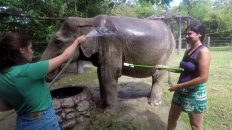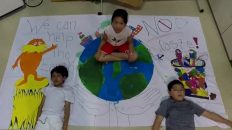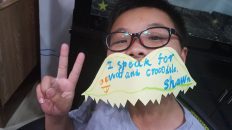Have you ever put off doing a project? Maybe because life got in the way, or maybe the date you wanted said project to be done kept being later and later that you just avoid it altogether?
We may have done above action individually, but when it comes to humans, as a collective species, destroying the habitat has not been part of ‘modern’ society’s procrastination, and it is high time we should put off doing so.
It is incredibly frustrating that a dollar sign has to be on everything on the planet in order to be worth something. Even more seething is the fact that the USA’s current political administration says cutting back on policies that have protected lands and animals for almost a century is detrimental to the economy.
And forests around the world continue to burn, whether it is due to greed and political destruction, or the ever increasing effects of climate change – it is clear that, unless we wake up and integrate, the world will continue to perish at the hands of humans.
Not only do we need to integrate with plants and animals, but we also need to integrate with other ways of life. The reality is our technological, first world country way of life needs to include the rest of the world. Gone are the days of “It’s not happening in my country, so it’s not my problem.” The planet is dying at an alarming rate, and we are the cause and the cure.
Indigenous peoples have long been the listeners of the earth – they know the interrelatedness of each plant, animal, life, and death. They have been persecuted and exploited for their knowledge and understanding of the community around them, and their amazing strength and kindness.
Example: Brazil’s rainforest, and the neighboring countries, and the indigenous tribes protecting the rainforest, are being burned to the ground so the government can make room for large agricultural monocultures such as soybean crops and cattle ranches. Our consumption habits are DIRECTLY RELATED to this demand. Also, the president Bolsonaro has openly praised the genocide of indigenous people, with horrifying words such as “It’s a shame the Brazilian cavalry has not been efficient like the Americans, who exterminated the Indians.”
OH YEAH, the Native Americans. Their people and culture is still alive today, and yet we still forget that things like Wounded Knee, where the US Army murdered hundreds of indigenous children and families, happened a little over 100 years ago. From 1960-1980, the US, in an arms race with Russia, extracted nearly 30 million tons of uranium from Navajo lands (again, more treaties written by colonists that were not honored, because America). In the Church Rock uranium mill spill, almost 1,000 tons of solid radioactive waste flowed into Navajo Nations rivers, and the waste still exists today, in the soil and in Navajo bodies in the form of cancer. Somehow, we still give large oil corporations eminent domain over land that is not theirs, continuously spewing hundreds of thousands of gallons of crude oil onto Native American reservations.
This time of year, especially after learning the true history of America, is difficult for me. How can I go to school, or celebrate with my family, a tradition that is enveloped in a lie? There was never a dinner, with pilgrims on one side and Native Americans on the other in beautiful harmony. We can agree that there was a feast, the pilgrims were actually called “Puritans”, and Squanto saved the Puritans because he spoke English and could teach them harvesting and hunting skills. Know why? 7 years prior to the Puritan settlers, Englishmen who were trading with Native Americans beat them and took them on ships to sell into slavery – Squanto was one of those men.
So what can I do? What difference can I really make?
I VOTE WITH MY DOLLAR.
Every purchase I make, I try to make sure that the company supports sound environmental and political choices. Instead of Black Friday, I will clean up a local park, participate in the Fridays for our Future Climate Strike, and work on fixing my car. I cannot force others to make the choices I do, but I hope I can provide some insight into alternatives, because the reality is we cannot continue to think that nothing bad will happen to us, or that our choices don’t directly affect the planet.
Also, education is super important. I remember learning about the myth that is Thanksgiving (thinking it was a true story) and thinking, “Where are the Native Americans now?” As if somehow I thought white people sailed to America, and the Native Americans just said, “Sure, take this whole continent. We have lived here for a thousand years, but we only need a little land. We’ll get out of your way.”
So educators: please introduce the story of thanksgiving much like Pete the Cat or The Lorax – a great story, with a good theme that we can learn from – not a turning point in American History. Because it isn’t.
In order to “be the change” and “speak for the trees” I will share with you some insight and resources as to how I try to bring inclusion and education to my students and family during this holiday season.
Friends and Family:
- Buycott – this is a phenomenal app that allows you to create a profile, choose what ‘campaigns’ you want to support and avoid, and then when you scan any item you are thinking of purchasing, will tell you if that company mirrors your values. Don’t want to support companies that use child labor? There’s a campaign for that. Don’t want to support companies that use palm oil, unsustainable and pollutive farming practices, or tests on animals? Yup, there’s campaigns for all of that too.
- Pinterest – A wonderful site/app that is a network of DIY-ers, complete with how to make your own cleaning solutions, upcycle old items to make art pieces, and even some amazing Earth-friendly holiday hacks and yummy dishes.
- Etsy – Want to support local artists? Etsy is the place.
- I would also like to invite anyone reading to actually GO to a local farm, store, curated art show, etc. during this holiday season for purchases. Supporting local is the way to go!
- Stand For Trees – Every year during the holidays (my birthday also falls around this time) the gift I request from my friends and family are more trees in the world. I have requested for the past 4+ years that anyone who wants to give me a holiday gift, to donate to an organization that helps the planet, instead of a gift. This organization is one of my favorites, but there are so many local and global organizations that need help. I would rather be helping the planet than have a thing. Some other phenomenal organizations are Amazon Frontlines, Plant With Purpose, and Heifer International.
- I also have to highlight The Walkabout Park because they are a phenomenal sanctuary that is currently evacuating their animals due to the New South Wales forest fires. I have been to this place, and will for sure be going the next time I am in Australia, and they need all the support they can get to help the land and animals that live there.
Students:
- The three books I am concentrating on when teaching my students, who are in Kindergarten through 3rd grade, are “Gracias, Thanks” by Pat Mora, “Whoever You Are” by Mem Fox, and “The Rough Face Girl” by Rafe Martin.
- Did you know that there is no Thanksgiving in Latin America? En Espanol, Thanksgiving, or “Dia Accion de Gracias”, literally translates to “Day of Thankful Actions,” and in reading “Gracias, Thanks” with my students, we want to think not only about what we are thankful for, but also what we can do to show our gratitude.
- The whole goal of “Whoever You Are” is to show children that there are people all around the world, and we all feel love, joy, and pain. We might look different, pray (or not) to various God/S, and celebrate different traditions – but we are all part of the ONE human race, and we all bleed red, so we should give love whenever possible.
- I am reading “The Rough Face Girl” with my older groups of students to get them thinking about WHO the writer is when we hear a story. This is a beautiful read with a Cinderella-esque storyline, so I want the students compare this story to what they have heard, and to think about their writing and reading. I want them to question when they hear a story, “Who wrote this? Who is benefitting from this? Who is being left out of this?”
If you have any ideas, thoughts, comments, questions, or want to collaborate and save the world, feel free to reach out and team with me to #bethesolution!
Happy Holidays!




